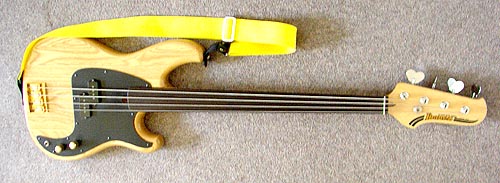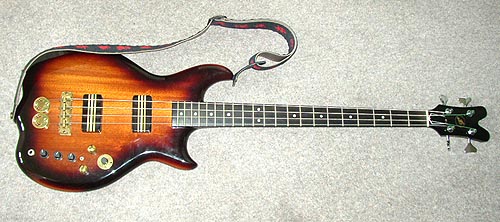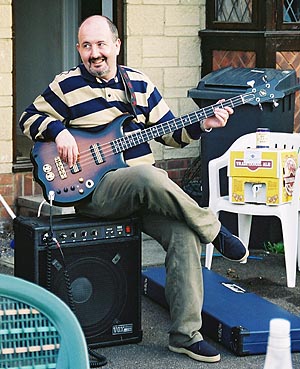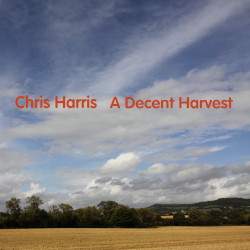Once I started fooling around on the guitar, I guess it was only a matter of time before I decided I ought to have a go at playing the bass as well.
Even before I started playing bass, my record collection included albums like Rocks, Pebbles and Sand by Stanley Clarke, and Champions by Jeff Berlin's Vox Humana. These were albums that I'd bought primarily because of the bass playing on them. Bass-driven music can have an incredible drive to it; it can really thunder along. Geddy Lee's playing in the Canadian rock band Rush is a case in point: even before I started playing myself I could tell that there was a stunning level of proficiency involved in what he was doing. As you'll see in a moment, Geddy's probably my biggest influence.
The interest in Motörhead helped, too: listen to any Motörhead album and you'll learn that very quickly. If you look behind the image, Lemmy was actually a highly innovative bass player. Knowing the sheer power required to play bass like a rhythm guitar convinced me very rapidly that the man had superhuman abilities.
I've gradually refined the gear that I use for adding bass to my recordings over the years, but some bits of kit that I bought when I was just starting out forty years ago are not just still with me, they are still in regular use. Top of the list, though, is a bass I've had my eye on since Fender introduced it twenty years ago: a Geddy Lee signature model Jazz Bass, which is a faithful replica of the '72 Jazz Bass that Geddy bought for $200 from a pawnshop in Kalamazoo, MI back in the 1970s. He used that bass on "about half of Permanent Waves" but it wasn't until 1993, when he picked it back up for recording Counterparts, that it really came into its own. Although Geddy has around 25 different models of the Jazz in his collection and many others by different manufacturers as well, the '72 Fender remains his main bass guitar to this day. I can see why; I love mine.
- Fender "Geddy Lee" Jazz Bass
- Jaydee "Roadie II Active Supernatural"
- Ibanez "Blazer" custom 4-string, fretless
- Ibanez RG9-BK 9-string guitar
- Chapman Stick, 10-string
- Boss BF2 Flanger
- Boss CE2 Chorus
- Zoom G6 effects processor (Stick lead side)
- Phil Jones Bass Briefcase Ultimate 2 x 5 150 W bass combo
- Blackstar Core:ID 15 1 x 12 15 W combo (Stick lead side)

This is the first bass I bought—an Ibanez Blazer, which I bought at a jumble sale in north London. It had been mutilated by its previous owner, who had ripped out its frets with a pair of pliers and filled in the resulting holes with Tetrion!
After a visit to Roger Giffin of Giffin Guitars in Kew, it now sports a proper ebony fingerboard and a Schaller bridge, and with roundwound strings on it, it's one of the best sounding fretless basses that I've ever heard. I'd never part with it voluntarily.
The next bass I bought was a considerable step up in just about every way. It's a Jaydee Supernatural "Roadie IIA". Unlike the Ibanez, it's "active", which means that the bass contains electronic circuitry to amplify its output signal. It also has a three-band eq built in for good measure. After a recent trip to my local guitar shop for some TLC (big thanks to Intersound Guitars in Dursley) it's playing very nicely once again.

Paradoxically, these days the instrument that I use to record quite a lot of the bass parts for my music isn't really classed as a bass at all. I moved into Extended Range Guitars territory a few years ago with an Ibanez RG9-BK nine-string guitar. The additional three strings below the guitar's standard EADGBE tuning are tuned C# F# B, low to high. That gives me a considerable reach in terms of notes to play, and with the signal DI'd into my DAW from a Zoom G6 effects unit, I'm really pleased with the tone I get.
And the RG9 is not the only instrument that I use for playing bass that isn't a bass: The Chapman Stick is still an uncommon instrument, even though Emmett Chapman invented it back in the 1960s. I've been playing one for over thirty years and I've put together a separate Chapman Stick page if you want to know more about it.

I do still occasionally play in public. I was persuaded to play Chapman Stick at a friend's birthday party in London a few years ago and apart from a few problems with the bass amp I was using, I had a great time.
The last time I played a bass guitar live was a considerably longer ago. A few of the local musicians, including me, got together during the Jubilee street party we held in 2002 for a bit of an impromptu jam session, and though we made most of it up as we went along, it was great fun getting everyone to sing along to a selection of old standards; it was the first time I'd played Jerusalem live and even if my rendition wasn't as accomplished as Greg Lake's, we all managed to get to the end at the same time and most of us even managed to stay in the same key!
As you can see, the 100 watt Vox Venue amp that I had at the time was quite useful as a convenient seat. And yes, that's a 40-pint container of BOB, a.k.a. Brand Oak Bitter, made by our local brewery over in Wickwar. Its presence may also have had something to do with why the day went so well...
When bass players start talking about slapping and popping, don't be alarmed. These are particularly funky ways of plucking the strings to get a more aggressive sound.
As you may have guessed from the fact that I own a Jaydee, it got to the stage after I'd been playing for a while where I hankered after the Level 42 sound. I wanted to be able to play ludicrous numbers of notes to the bar just like Mark King. So I shut myself away in the back bedroom of my last house with my first bass amp (I'm sitting on it in the photograph above; it was a second-hand, hundred watt Vox Venue 1 x 15 combo that sadly eventually died on me), plugged a pair of headphones into the back of it so that I didn't drive the neighbours mad, and tried to figure out how it was done.
Initially it was one of the most frustrating things I've ever played. I'd see all the flash players on TV hammering on and pulling off without any effort whatsoever, but try as I might my hands wouldn't produce the same noises. Then, one evening, in the space of about five minutes, something clicked inside my gead and I "got" how you did it. There was no gradual shift—one minute, I was flailing about with no idea of what I was doing and the next I was snapping and popping with the best of them. It's still one of the strangest learning experiences I've had (and as a professional instructional designer, I've had quite a few of those in my time), but it makes the point: keep practising, because things might click for you in the next five minutes.
Those five minutes were also the point at which I realised that I had become a "proper" bass player. From then on, I started listening carefully to how bass players approached what they played to see if I could figure out what they were doing too.
Since then I've diligently worked out as many bass lines as I could (or come up with an approximation of the original artist's playing that could almost be convincing with a following wind and after a few beers, at least). But in playing along with countless records, I learned something that was far more valuable than being able to copy someone else's style: I learned how to play to the beat, and what it feels like to play just ahead of it, or just behind it.
Because a bassist must work with the drummer to establish not just the tempo of the music, but also mystical qualities that are given odd descriptions such as "playing in the pocket" or "locking in" or—simply—the "groove". The rest of the band rely on the groove that the bass and drums lay down so that they can do what they do over the top without everything disintegrating. If you've ever played in a band you will be well aware of how often it is that the guitarist is more interested in self-indulgent plank spanking and fret wankery (which are equally well-known terms in musical jargon) than they are in playing in time, and the keyboard player will either be making silly farting noises with their synths or playing "Jump." Been there, done that, bought the t-shirt.
So how do you learn to keep a regular beat? Well, practising with a drum machine going in the background has worked well for me. I found that if you practise for long enough you will develop an ear for a steady tempo. Again, if you persevere you eventually develop the weird ability to recognise when the tempo drifts—not just when you're playing in a band, but even when when you're listening to a recording. There's nothing inherently wrong with a drummer who speeds up or slows down in response to the feel of the song; Charlie Watts of the Rolling Stones is a master of doing it properly, but these days I no longer wonder why using a click tracks is so popular...
Over the years I've tended to gravitate towards lighter strings - the Jaydee in particular is much easier to play with lighter gauges and it doesn't knacker your hands quite as much when you play it for extended periods. Why make things harder for yourself, eh?
Apart from being the title of a Mark King solo album, influences are very important in shaping your playing style. Aside from the Level 42 bassman, I particularly admire the playing of Nick Beggs, Jeff Berlin, Stanley Clarke, Les Claypool, John Giblin, Stu Hamm, Jonas Helleborg, Dave Holland, Mick Karn, Geddy Lee, Tony Levin, Matthew Seligman, and (of course) Lemmy. Even though several of these artists are no longer with us, they continue to shape my playing in one way or another. The astonishing playing of Vulfpeck's Joe Dart has made a big impression on me in recent years.
I've put a page together with some information on the musicians who have had a great effect on me - you'll find it on my groups page.
Over the past decade or so I have become much more interested in writing and recording my own music in my home studio. Not to put too fine a point on it, it has become an obsession. In an attempt to explain just why this has happened, I've put together a Music Page which provides an account of how my musical started, where it's got to, and where it might be going.
You can hear some of the early results of my activities, including some of my bass playing, on my Soundcloud page. Soundcloud is used more for historic purposes than anything else. It continues to be a mess of scams and "buy more listens!" comment spam, so I don't use it any more.
These days, I have transferred my online musical activities to Bandcamp. I drop an album there every month at the moment. My discography includes music that ranges from pop to prog, from ambient to spoken word, and from mellow piano ballads to shouty post-punk. The latest release is a selection of music I wrote during April 2021 for the Fifty/Ninety: The Prequel songwriting challenge, and as the results were—in my humble opinion—rather good, I've called it A Decent Harvest. As with its predecessors, it's a pay-what-you-want deal and that includes free.
Some links I've found interesting or helpful:

